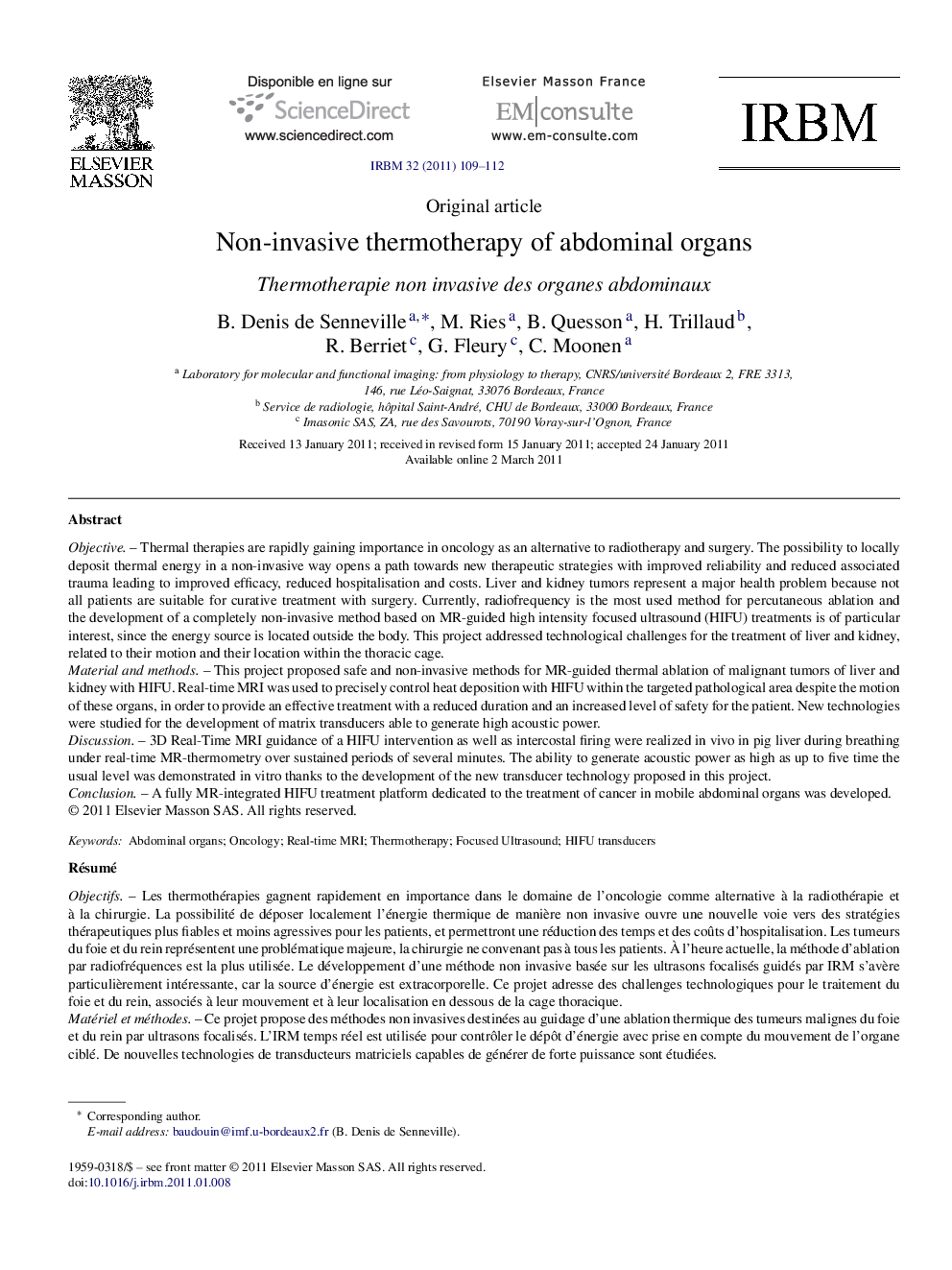| Article ID | Journal | Published Year | Pages | File Type |
|---|---|---|---|---|
| 870954 | IRBM | 2011 | 4 Pages |
ObjectiveThermal therapies are rapidly gaining importance in oncology as an alternative to radiotherapy and surgery. The possibility to locally deposit thermal energy in a non-invasive way opens a path towards new therapeutic strategies with improved reliability and reduced associated trauma leading to improved efficacy, reduced hospitalisation and costs. Liver and kidney tumors represent a major health problem because not all patients are suitable for curative treatment with surgery. Currently, radiofrequency is the most used method for percutaneous ablation and the development of a completely non-invasive method based on MR-guided high intensity focused ultrasound (HIFU) treatments is of particular interest, since the energy source is located outside the body. This project addressed technological challenges for the treatment of liver and kidney, related to their motion and their location within the thoracic cage.Material and methodsThis project proposed safe and non-invasive methods for MR-guided thermal ablation of malignant tumors of liver and kidney with HIFU. Real-time MRI was used to precisely control heat deposition with HIFU within the targeted pathological area despite the motion of these organs, in order to provide an effective treatment with a reduced duration and an increased level of safety for the patient. New technologies were studied for the development of matrix transducers able to generate high acoustic power.Discussion3D Real-Time MRI guidance of a HIFU intervention as well as intercostal firing were realized in vivo in pig liver during breathing under real-time MR-thermometry over sustained periods of several minutes. The ability to generate acoustic power as high as up to five time the usual level was demonstrated in vitro thanks to the development of the new transducer technology proposed in this project.ConclusionA fully MR-integrated HIFU treatment platform dedicated to the treatment of cancer in mobile abdominal organs was developed.
RésuméObjectifsLes thermothérapies gagnent rapidement en importance dans le domaine de l’oncologie comme alternative à la radiothérapie et à la chirurgie. La possibilité de déposer localement l’énergie thermique de manière non invasive ouvre une nouvelle voie vers des stratégies thérapeutiques plus fiables et moins agressives pour les patients, et permettront une réduction des temps et des coûts d’hospitalisation. Les tumeurs du foie et du rein représentent une problématique majeure, la chirurgie ne convenant pas à tous les patients. À l’heure actuelle, la méthode d’ablation par radiofréquences est la plus utilisée. Le développement d’une méthode non invasive basée sur les ultrasons focalisés guidés par IRM s’avère particulièrement intéressante, car la source d’énergie est extracorporelle. Ce projet adresse des challenges technologiques pour le traitement du foie et du rein, associés à leur mouvement et à leur localisation en dessous de la cage thoracique.Matériel et méthodesCe projet propose des méthodes non invasives destinées au guidage d’une ablation thermique des tumeurs malignes du foie et du rein par ultrasons focalisés. L’IRM temps réel est utilisée pour contrôler le dépôt d’énergie avec prise en compte du mouvement de l’organe ciblé. De nouvelles technologies de transducteurs matriciels capables de générer de forte puissance sont étudiées.DiscussionLe guidage 3D en temps réel d’une intervention par ultrasons focalisés avec un tir intercostal a été réalisé in vivo sur le foie de cochons en respiration libre, en combinaison avec une thermométrie temps-réel pendant une durée de plusieurs minutes. La possibilité de générer des niveaux de puissance acoustique plus de cinq fois supérieurs aux niveaux habituels a été démontrée in vitro grâce à la mise en œuvre de la nouvelle technologie de transducteur proposée dans ce projet.ConclusionUne plateforme ultrasons focalisés intégrée à l’IRM et destinée au traitement du cancer sur les organes abdominaux a été développée.
